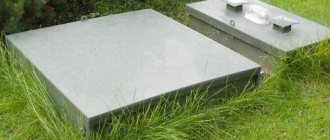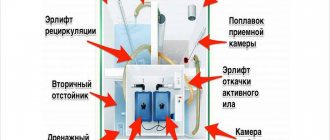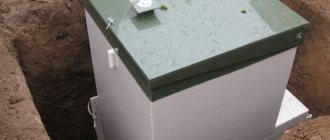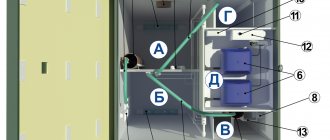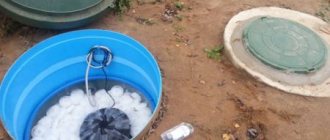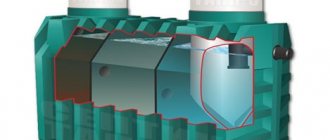How to properly preserve a Topas septic tank for the winter with your own hands
Preservation of the Topas septic tank for the winter includes a number of procedures:
The WWTP is disconnected from the power supply. Compressors and pumps are removed from the corresponding chambers. Clean the receiving chamber from non-recyclable particles. The sludge stabilizer is emptied using the built-in airlift. The contents of the tanks of the Topas septic tank are clarified according to the manufacturer’s instructions: 40% of the volume of one chamber is pumped out, filled with clean water, the process is repeated until the liquid is completely cleared.
Attention! It is not allowed to pump out liquid from all tanks at the same time. Violation of conservation rules threatens deformation or floating in the presence of groundwater.
Water clarification in the septic tank is carried out chamber by chamber, following the sequence: sludge stabilizer -› aeration tank -› receiver. After filling the WWTP, clean water in the aeration tank chamber should reach the following level:
- 35 cm from the upper edge of the interchamber partition of the aeration tank;
- 10 cm to the bottom edge of the inset of the supply pipe of the primary chamber, but not less than 10 cm to the bottom of the storage tank in the Topas septic tank with forced drainage of wastewater;
- 15 cm from the upper edge of the interchamber partition of the sump;
Individual elements of the device, including airlift pumps, are washed. The clean water outlet pipe on the septic tank is sealed with a forced-type clamp and a plug for the sludge pump. Individual station cells are equipped with pre-prepared 1.5-2 liter plastic bottles with sand. When submerged, the ballast must assume a vertical position. By tying the bottles by the neck, the pressure on the walls of the chambers from the freezing ice crust will be significantly reduced. The Topas septic tank is insulated from the outside with old, unnecessary things, polystyrene foam, and straw. The groundwater temperature is +4°C year-round, and the station’s water will maintain a similar regime.
Recommendations for insulating a septic tank for the winter
When purchasing factory models, you can read the instructions with all the information. But many people neglect this, and they have to look for the necessary information on the World Wide Web. For this purpose, recommendations for insulating a septic tank for the winter are presented.
Tips for preserving the device:
- It is necessary to follow the sequence of all operations.
- Be sure to insulate the septic tank lid. To do this, use dense material at hand (hay, straw, polystyrene foam) or specially purchased insulation products.
- The best time for preservation is the beginning of winter, when there are still no severe frosts.
- When using a septic tank all year round, it does not need to be preserved.
During mild winters, the device does not need to be insulated. Preserving the septic tank will help you survive harsh climatic conditions, as it creates comfortable conditions for bacteria. The temperature inside the chambers remains plus 4 degrees.
Re-opening of the Topas septic tank
Preparing a septic tank for operation after winter storage requires a number of procedures:
- External inspection of the Topas cover for integrity and absence of visible damage.
- Comparison of the contents of the chambers with the level provided during conservation.
- Checking the liquid level in drainage wells and storage tanks.
- Filling the septic tank chambers with water to the operating level.
- Checking the condition of compressor filters.
- Supplying power, checking the functionality of the installed system.
- Compressor and pump installations.
- Checking the performance of float sensors for switching cycles of water treatment plants, alarm systems, air lifts, air lines;
- Testing of the drainage line from the Topas septic tank.
The ability of bacteria to self-heal will gradually return the septic tank to working condition after 2-3 weeks. Purchasing bacteria for septic tanks or adding spoiled fermented milk products to the receiver will help speed up the process of biomass reproduction after conservation.
Why doesn't Topas freeze?
In working condition, the liquid in the compartments of the septic tank is always in motion. This is achieved thanks to air compressors, which work constantly and, due to the air, constantly move the liquid and cause aeration (seething) in the compartments. Plus, the topas lid is insulated and sealed, and the compressors themselves also give off a little heat during operation. Do not forget about warm sewage, which also enters the topas.
Operation of Topas in winter
Important points of conservation
Theoretically, conservation of Topas is a fairly simple process to do with your own hands, however, in practice, beginners often make mistakes:
Complete drainage of the septic tank. The light weight of the station body threatens to float when the groundwater level rises in the spring, and the sewerage system will completely fail.
Improper insulation by sprinkling the lid with soil or sand; when snow melts and rains, bulk materials fall inside the system. In the spring, you have to re-clean the filters and septic tank chambers.
Failure to use ballast with sand increases the risk of destruction of the septic tank body. When water freezes in blocks, plastic bottles prevent critical deformation of the body.
What to do if Topas is frozen?
The topas itself can freeze only in the event of a long power outage at the dacha. The top layer of water freezes (including in various tubes) and requires defrosting. This is done mechanically and using warm water.
In other cases, only sewer lines freeze. And not even all the pipes, but the purified water drainage pipe coming from the septic tank. In topas models with forced drainage of water using a drainage pump, this pipe is quite flexible and thin. Due to ground movements or poor installation, sags form in the pipe, in which water remains, which successfully freezes.
In this case, you need to defrost this pipe and, ideally, reposition it without allowing it to sag. As an option, you can install a heating cable that will run from the topas along the entire length of the pipe.
The sewer pipe from the house to the septic tank almost never freezes. In our practice, at the moment there have been only 3 cases when an ice plug formed inside the pipe. And the frozen part was always in the open air and without insulation.
Our service department has extensive experience in defrosting septic tanks Topas, Astra, Yubas and others. Despite the fact that defrosting topas seems like a simple job, each visit is a long process that requires a certain skill and understanding of the physics of the processes, what and where needs to be defrosted and how to check the performance of the septic tank after the work has been done. You can call a specialist by phone: +7 (499) 391-68-35.
How to do without conservation
If you plan to use the Topas septic tank 2-3 times a month, it is not necessary to preserve the system. Working compressors will ensure the flow of processes that support the vital activity of bacteria. The operating costs of the device correspond to the level of energy consumed.
Pay attention! The Topas system does not freeze, thanks to maintaining a temperature of 10-11 degrees in the workstation.
The condition is achieved by a number of features:
- Using high quality polypropylene foam.
- Compression of air, accompanied by the release of heat.
- The process of biological oxidation of bacteria.
Insulation of a homemade septic tank
Self-made cleaning stations usually have simple control systems, and therefore are easier to preserve. Adjust the exact algorithm based on the design of your specific septic tank. Minimum steps for conservation:
Insulation of a septic tank
- As with industrial septic tanks, first disconnect the unit from the power source.
- Disconnect and remove any equipment that could be damaged by freezing temperatures.
- Check that the amount of water in the septic tank is at least 75%.
- If the unit is mounted on a concrete slab, drain the fluid from the chambers.
- Additionally, insulate the structure if the climate in your region is cold in winter.
Advice. In order for bacteria to survive in winter, among other things, they need air. Therefore, when insulating, do not overdo it with insulation. In any material you need to make several holes for ventilation.
Answers on questions
How much does it cost to preserve a Topas septic tank?
Conservation of the Topas septic tank by third-party companies will cost at least 4,000 rubles. Wanting to save money, many owners of small-sized models carry out septic tank maintenance themselves. The process will take 3-4 hours.
Can groundwater push Topas out of the ground?
No. The side supports of the housing prevent the system from being pushed out of the pit. The structure is also filled with water after conservation, adding weight to the product.
Can bacteria die without food?
Yes, if the septic tank is not used in winter, the bacteria inside die. Preserving the installation or periodically adding fermented milk products to the receiving chamber will help solve the problem.
How the Topas septic tank works in winter: operating features
Under intense loads, the device can last for a long time. The owner of the Topas septic tank can choose the operating time of the device: all year round or stop its operation for the winter. Even if preservation for the winter was not initially planned, you can make this decision spontaneously. You can do the insulation yourself or contact a service that will carry out both conservation and commissioning of the equipment.
How the Topas septic tank works in winter:
- The functional performance of the device does not change;
- High temperatures during operation of the septic tank do not allow the device to freeze;
- The polypropylene body also helps to insulate the device;
- Aerobic bacteria, processing wastewater, produce heat, which prevents the device from freezing.
All factors indicate that a working septic tank will not be able to freeze in the winter. But if in doubt, you can insulate the upper part of the device. If the device is installed in northern regions, it is recommended to perform additional insulation.
In the spring, the septic tank is re-opened. The sequence of stages occurs in reverse order compared to winter work.
All procedures will not take much time and effort. It is enough to follow the instructions consistently. It is important to do everything carefully so as not to accidentally damage the system.
When is it necessary to preserve a septic tank?
In accordance with the manufacturers' recommendations, the septic tank must be prepared before the winter period, when the temperature is still above zero. Care must be taken to ensure that the recycler does not freeze. If there are doubts about the depth of freezing, you can protect the structure using a well-known folk method. A little sand is poured into plastic bottles and lowered to the bottom of the disposal, where the water is. This is how “floats” are formed. They are usually immersed half their height. They act as a counterweight. Bottles with sand protect the structure and walls of the chambers from the expansion of the ice crust and help prevent damage to the biological treatment station. Homemade septic tanks freeze quite often in winter. To avoid freezing of the treatment unit, it is recommended to use insulation. Basically, today, autonomous sewage systems are made of concrete rings and concrete poured into formwork. Various containers and reservoirs are widely used. Brickwork and stone are also used. In such cases, it is necessary to take care of insulating the part that protrudes outward, including sewer pipes. You can watch a video about septic tank maintenance in winter to get more information. In some cases, even an insulated disposal can freeze. In this case, you need to find out the true cause of freezing. Common causes include improper installation of the unit, poor system insulation and significant deficiencies in the treatment equipment system. In addition, poor sealing of the equipment can lead to the penetration of cold air into the system, and as a result, can cause freezing of the biorefinery station. There are various ways to revive an autonomous sewer system. Warming up with hot water is considered the most effective. To do this, you will need to fill all sinks and drains with hot water. Thanks to this, it will be possible to melt the ice in the pipes and system. Saline solutions can be used. But after this, it is definitely recommended to rinse everything with plain water, since saline solutions have a strong corrosive effect. You can also “warm up” the structure using a gun powered from an outlet. Much will depend on the degree of freezing of the biological treatment plant. It is best to consult with experienced specialists to avoid damage to the cleaning unit at the most inopportune time. If you are planning to purchase cleaning equipment for your country house, then be sure to discuss the issue of protecting it from freezing in winter. It is advisable to discuss this with the design engineers in advance. To prevent freezing, many install a heating cable. Alternative options for heating the system in winter are also possible. Try to get more detailed information from the company managers or installers performing installation and maintenance.
Welcome to Unipedia
- Articles
- Sewerage
- Preservation of a septic tank for the winter
Owners of country plots usually live only during the summer season. The use of the autonomous system occurs precisely during this period of the year. When leaving the plot in the fall, you need to take care of the safety of the sewer system and septic tank, respectively. The process of freezing and thawing leads the water masses in the soil to various processes, which can lead to complete destruction of the reservoir, lead to a violation of sealing, and other functional issues. To avoid undesirable results, you need to familiarize yourself with common mistakes.
Incorrect process of wintering the sewer system of a country house
The very first mistake is draining liquid from the sewer system to zero. If you completely empty the septic tank, the flood in the spring, especially if the site is located in a lowland and has a high groundwater level, without solid fasteners, you will float in a pit full of water. This incident is far from the worst thing that can happen.
The soil is always moving. Various natural mechanisms set the soil in motion, which enormously increases the load on the structure. Plastic products may not withstand the load, lose their original shape, the container is deformed, this entails a change in volume in m3, or completely lose functionality, bursting, or another loss of tightness.
If the properties are lost, the device must be dismantled if repairs cannot restore the required qualities to the tank. The very first thing is not to leave the septic tank empty. There is no need to confuse it with the heating system. It is possible and necessary to clean the system before preservation as a preventive measure, but in this case you need to fill the container with water. The reservoir must be filled to 75% of the total volume. This weight will keep the septic tank in its original position.
Preservation of the septic tank for the winter
Automated cleaning stations have detailed instructions for preserving equipment for the winter period.
Most plastic septic tanks have a similar not only contraction, but the preparation stages are also very similar:
- Septic tanks with electrical equipment and sensors are first disconnected from the electrical network. You can de-energize the station in any convenient way, using a switch in the house or at the station itself;
- The next procedure is to remove (turn off) the air compressor. Disconnection is quite simple, since the unit is secured with special clips;
- a system that has a forced discharge function requires turning off the pump, otherwise all the remaining liquid will be discharged into the ground;
- the liquid is measured, as mentioned earlier, the container should be 3/4 full;
- very often after taking measurements it turns out that there is not enough fluid. You can't leave it like that. The missing amount must be added to the required level;
- It is closed with a lid and insulation is done.
The septic tank is insulated with various materials, for example, polystyrene foam, polystyrene foam, building insulation materials suitable for this type of insulation. The insulation is fixed on top; the most common way is to place heavy stones to fix the position of the light material. Regions of the country that do not experience severe winters do without insulation.
Advice for owners of industrial septic tank models
Models that have a sludge stabilization function have a built-in air lift; they must be cleaned before storage, remembering to fill with liquid.
All accumulations, including the first receiving chamber, are also cleaned of all solid particles.
If it is not possible to insulate with specially produced materials, resort to the old “old-fashioned” methods, wrap the hatch with straw, dry grass, or cover it with unnecessary fabric and oilcloth on top.
The start of work should fall during the period of the first frost, when the earth has “set”. Work carried out at such a time reduces the risk of distortion of the septic tank design.
To prevent ice from appearing inside the structure, especially in the northern regions, you need to make several floats. For production you will need:
- 1.5-2 liter plastic bottles;
- sand;
- rope;
Pour sand into a plastic bottle so that the upper part remains vertical on the surface. We tie a rope to the neck of the container. We lower the floats into the septic tank, fix the rope in such a position so that it can be easily removed during re-opening.
These little tricks will help prevent damage during severe frosts, thereby saving your budget.
Homemade septic tanks in winter
Often septic tanks are made independently from various available materials, but what about when winter comes? A huge advantage in this situation is the absence of complex sensors and other automation - this simplifies the process. Preparing a homemade septic tank for winter goes through the following stages:
- if there is a connection to the mains, turn off the power;
- remove equipment that is susceptible to damage, if any, compressor, pump;
- fill the tank to the required level;
- insulate the septic tank lid.
In the northern regions, additional insulation is usually done; you can leave a piece of the material used to insulate the hatch for the winter. Floats can also be installed.
Reactivation of a septic tank during the thaw period
With the arrival of warmer weather, life in the suburban area begins to gain momentum. Before you start using the septic tank, you need to reactivate it and return it to working condition. Resuming the operating state occurs in the reverse order:
- First of all, we remove the insulation left for the winter;
- remove the remaining floats;
- we install pumping equipment, compressor, sensors in their original place;
- checking connections;
- connect to the power supply.
Ready to use!
Important to remember
After wintering, the microorganisms that previously lived in the septic tank can no longer process organic substances in the wastewater; the biological mass must be replaced, since low temperatures cause the death of useful biologically active components. It is better to use new bacteria during a period when the temperature does not drop below +5°C; at this temperature, the death of biological mass does not occur.
Whatever the thermal insulation, bacteria cannot withstand such temperature pressure, so every spring it is necessary to replenish the septic tank with aerobic bacteria if the system has an air supply to the tank.
Preservation of a septic tank for the winter
Internal structure of a septic tank Unilos Astra
Preservation of a septic tank, installation of equipment
Insulating a septic tank for the winter with polystyrene foam
Liquid level in the septic tank when preserving the septic tank for the winter
At what frequency of septic tank use is equipment conservation necessary?
In most cases, if you visit a country house once every two or three weeks, then preserving the septic tank for the winter with your own hands is not required. However, if you leave your property for a longer period, you will need to prepare the septic tank for winter. The bacteria that are inside the biological treatment plant need constant nutrition and new portions of wastewater. A significant break in such nutrition can lead to the death of microorganisms that perform the main function. In addition, when processing wastewater, bacteria generate significant heat, which provides additional protection for the waste disposal unit from cooling. Manufacturers provide instructions for each specific model of autonomous sewage system. The manufacturer's documentation usually contains conservation information for a given device. We will look at general principles and nuances that will help prepare treatment equipment for low temperatures.
Stages of conservation of a biological treatment plant in winter
- De-energizing equipment. The cleaning unit must be disconnected from the power supply system. Additionally, you need to disconnect the air filter and drain pump if one was used. Typically, all electrical appliances are located on top of the device, so they are quite easy to dismantle. All dismantled instruments and devices must be stored in a warm room.
- Removing solid sediment. The receiving chamber of the biological treatment station must be cleared of sediment. If this is not done, the sediment will begin to decompose. Subsequently, during operation in the spring, an unpleasant odor will appear and the liquid in the system will be cloudy.
- Flushing all components. The septic tank drain needs to be flushed before winter. In addition, it is necessary to rinse hoses, nozzles and other devices from dirt and waste residues. If the system has a built-in airlift or stabilizer, it also needs to be washed and cleaned.
- Checking the water level. Before turning off the septic tank in winter, you need to make sure that the treatment device is filled with water. The volume of liquid should be about 70% of the total volume of the tank. If there is not enough water, you need to add it.
- Insulation of the system. It is recommended to insulate the upper part of the waste disposal unit, which is located above the ground. In regions where the temperature drops to zero degrees in winter, there is no need to insulate it. If in winter the temperature drops below zero, then insulation is required. For these purposes, you can use polystyrene foam, expanded polystyrene, expanded clay and other thermal insulation materials. It is also important to insulate the cover of the unit; you can use an old blanket.
In addition, it is recommended to insulate the sewer pipes through which wastewater is discharged. Insulation must be carried out not only from above, but also over the entire surface of the sewer network. For this purpose, various insulating materials can be used. This is recommended for pipes that are located above the ground.

